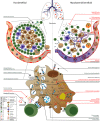Host-directed therapy to combat mycobacterial infections
- PMID: 33565103
- PMCID: PMC8248113
- DOI: 10.1111/imr.12951
Host-directed therapy to combat mycobacterial infections
Abstract
Upon infection, mycobacteria, such as Mycobacterium tuberculosis (Mtb) and nontuberculous mycobacteria (NTM), are recognized by host innate immune cells, triggering a series of intracellular processes that promote mycobacterial killing. Mycobacteria, however, have developed multiple counter-strategies to persist and survive inside host cells. By manipulating host effector mechanisms, including phagosome maturation, vacuolar escape, autophagy, antigen presentation, and metabolic pathways, pathogenic mycobacteria are able to establish long-lasting infection. Counteracting these mycobacteria-induced host modifying mechanisms can be accomplished by host-directed therapeutic (HDT) strategies. HDTs offer several major advantages compared to conventional antibiotics: (a) HDTs can be effective against both drug-resistant and drug-susceptible bacteria, as well as potentially dormant mycobacteria; (b) HDTs are less likely to induce bacterial drug resistance; and (c) HDTs could synergize with, or shorten antibiotic treatment by targeting different pathways. In this review, we will explore host-pathogen interactions that have been identified for Mtb for which potential HDTs impacting both innate and adaptive immunity are available, and outline those worthy of future research. We will also discuss possibilities to target NTM infection by HDT, although current knowledge regarding host-pathogen interactions for NTM is limited compared to Mtb. Finally, we speculate that combinatorial HDT strategies can potentially synergize to achieve optimal mycobacterial host immune control.
Keywords: Mycobacterium avium; Mycobacterium tuberculosis; drug resistance; host-directed therapy; nontuberculous mycobacteria.
© 2021 The Authors. Immunological Reviews published by John Wiley & Sons Ltd.
Conflict of interest statement
All authors declare no competing or conflicting interests.
Figures

References
-
- World Health Organization . Tuberculosis. https://www.who.int/news‐room/fact‐sheets/detail/tuberculosis. 2020.
-
- Kawai T, Akira S. TLR signaling. Cell Death Differ. 2006;13(5):816‐825. - PubMed
Publication types
MeSH terms
Substances
LinkOut - more resources
Full Text Sources
Other Literature Sources

